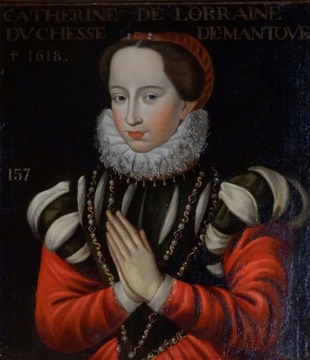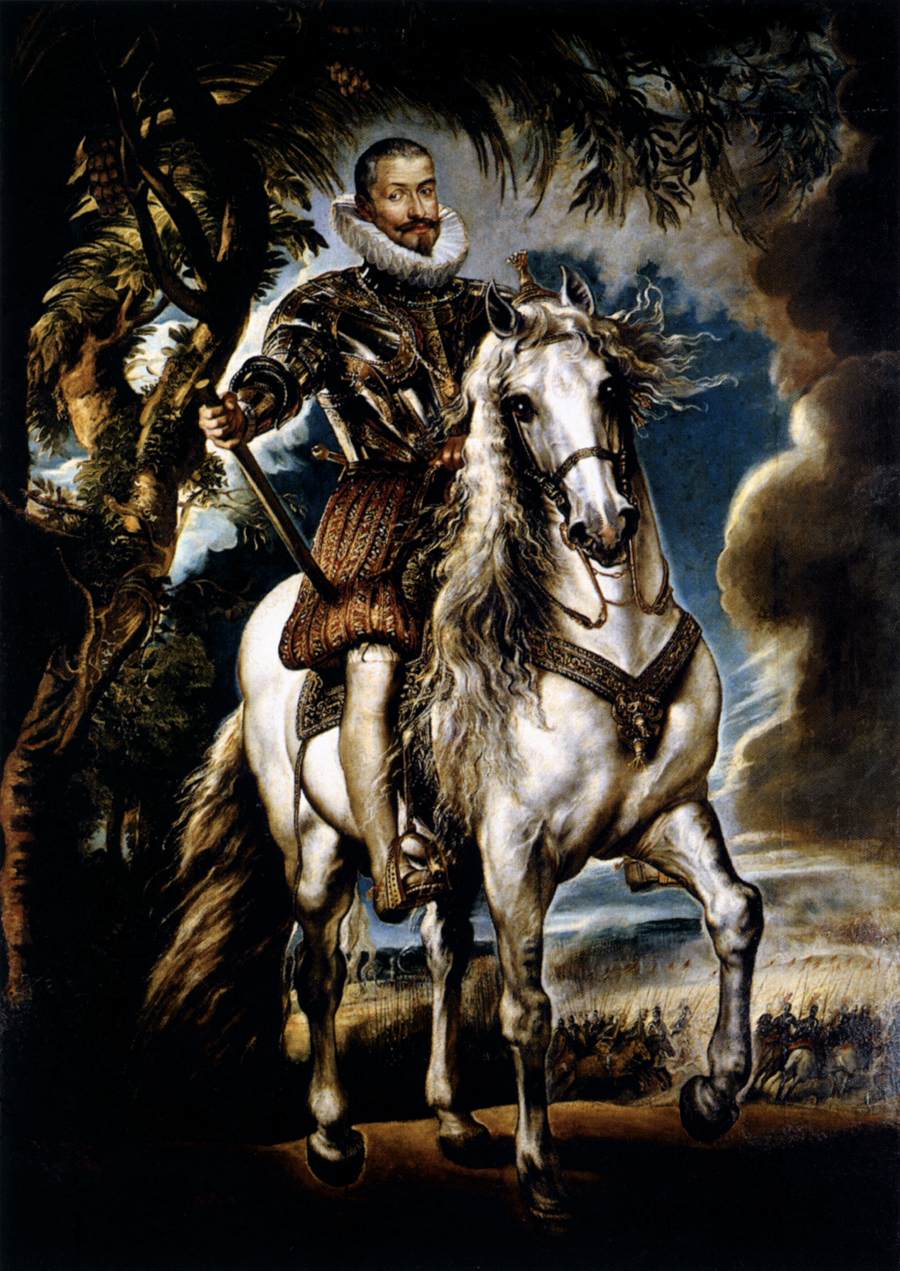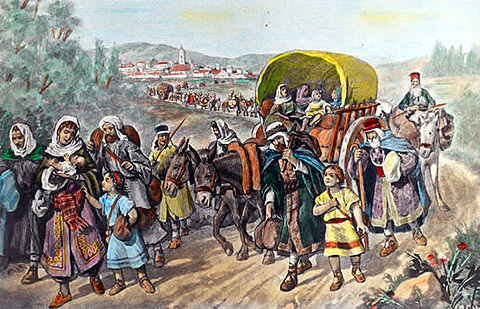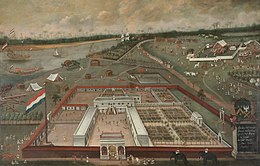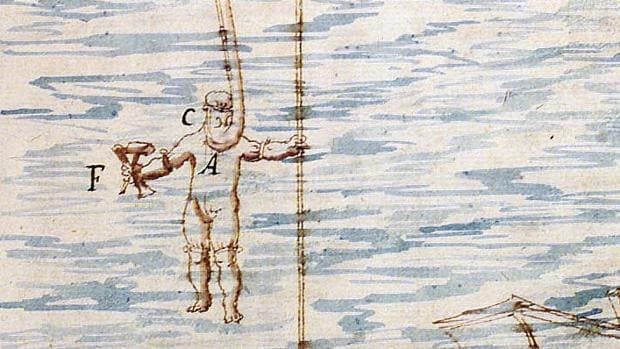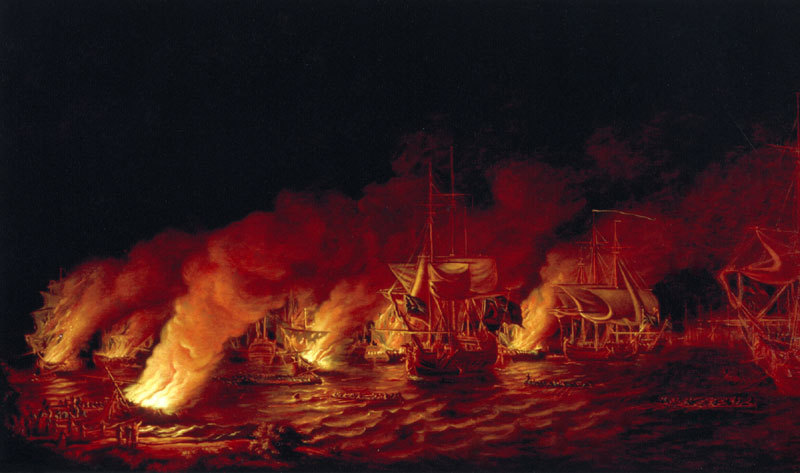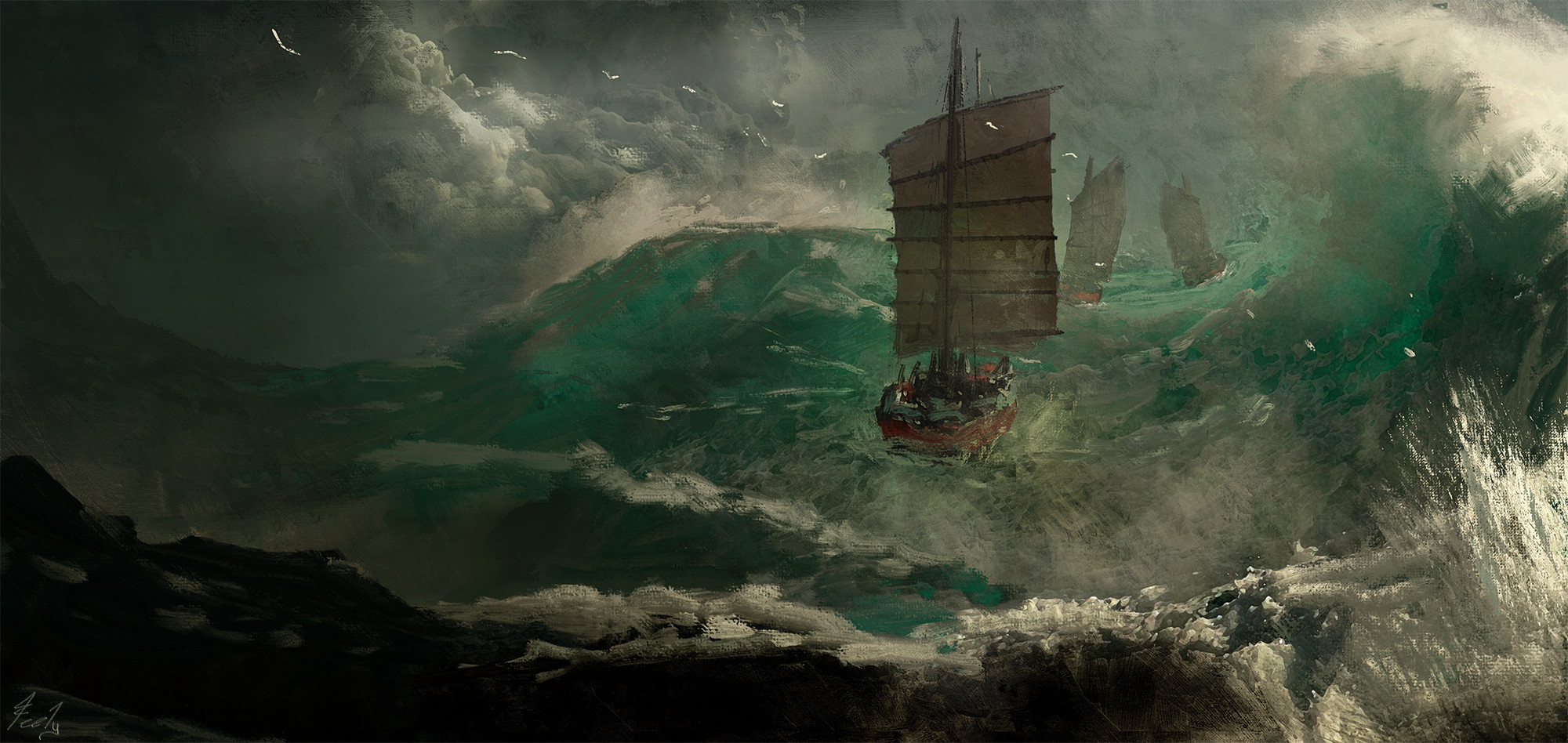«España esta afrontando un reinado oscuro».
«Spain is facing a dark reign».
— Anonym
Felipe I's successor would be Felipe II, son of Felipe I and Catherine-Marie de Lorraine, a French princess from the house of Guise. Catherine was the second child of Francis, Duke of Guise, and Anna d'Este. She grew up during the French Wars of Religion, a civil war between Protestant and Catholic factions. In 1570 she married Philip I, before giving birth to four sons and one daughter. Of which only one would survive: Felipe. He himself would be born in the fortress of Toledo at two in the morning. Philip grew up pampered and yet received a consistent and stable education that made him be considered quite intelligent to the point that he frequently ordered the purchase of books to form a "school" library for the prince, made up mostly of history books. of Spain, the crown of Aragon, the history of Portugal, technical disciplines, such as astronomy and cartography. His bibliophile became a reflection of his wide culture and variety of his interests, which was accompanied by the collecting of rare objects and antiques to form an authentic "camera of wonders", characteristic of so many Renaissance princes. However, he was prone to exaggerated behavior that caused problems and discomfort, such as when in a hunting raid, he burned several hares alive, including a pregnant one, these sadistic behaviors would also include the sexual plane when he would experience having relations with several servants and maidens. of her sisters Isabella and Catalina. The whims were normally settled with a ridiculous compensation to the victim's father and the transfer of the maiden to another place away from Felipe. However, these behaviors that were hidden, were hidden under a pleasant and intelligent personality where he made use of his love of theater, painting and, above all, hunting to relate and achieve being loved while delegating his government in his Valido: a position comparable to the figure of the Prime Minister, although the position depended on the confidence of the king.
Philip II's accession to the throne came with great promise, as the new ruler replaced many of the court's prominent officials, most of them elders who served during the reign of his father and grandfather, with younger men. youths. Perhaps the most outstanding measure would be the appointment of Valido to Francisco de Sandoval, Marquis of Denia, and later, Duke of Lerma, who had been a page of the sons of Philip I and chief groom of the prince before being this King. The Duke of Lerma, showed himself to be a man of little intelligence and culture, ambitious and unscrupulous in the extreme. However, his policy from the beginning was focused on establishing an international peace, expelling the last Moorish redoubts from Spain while enriching himself personally through a masterful campaign of accounting and mortgage fraud, embezzlement and large-scale corruption where he dedicated himself to buying a large number of of houses, palaces and lots throughout Spain while managing influence peddling and the sale of public offices. This was concealed by hiring outstanding architects and using the best materials to enhance and beautify the capital and other great Spanish cities. On the other hand, in 1608 the Treaty of London was signed where the Empire of Spain signed a peace treaty with the Kingdom of England (which was in Personal Union with Scotland), the Treaty of London was favorable to Spain where James I of England promised not to intervene in continental affairs while suspending the activities of corsairs in the Atlantic Ocean, renouncing any kind of aid to the rebellious Netherlands, opening the English Channel to Spanish shipping, and prohibiting its subjects carry goods from Spain to territories in conflict with Spain. Spain, however, promised to withdraw Spanish troops while diminishing Spanish support for the formation of the English Catholic priesthood.
The Peace of London as it would be called, would guarantee that the following year, the Duke of Lerma would have troops available to carry out the Expulsion of the Moriscos. This initiative was supported by almost all sectors of the Spanish population: Nobility, clergy and peasantry, mostly fearing a possible collaboration between the Moorish population and the Ottoman Empire against Christian Spain. This opinion was reinforced by the numerous incursions of Barbary pirates, which were sometimes facilitated or celebrated by the Moorish population and which continually devastated the entire Mediterranean coast. The Moriscos were considered a fifth column, and potential allies of the Turks or Protestants. On the other hand, shortly after accessing the throne in 1598 after the death of his father Felipe I, Felipe II made a trip to the Kingdom of Valencia accompanied by Francisco Gómez de Sandova, great Moorish lord and spokesman for the Valencian nobility. . When he left there in May 1599, the king wrote a letter to the archbishop of Valencia and patriarch of Antioch, Juan de Ribera -a strong supporter of the expulsion- in which he gave him precise instructions for the evangelization of the Moors through preaching and the dissemination of a catechism that his predecessor in the archbishopric had written. These instructions were accompanied by an edict of grace issued by the inquisitor general. However, the evangelization was carried out with excessive inquisitorial zeal since the preachers sent by Patriarch Ribera to the Moorish populations transformed the exhortations into threats and also unilaterally reduced the term of the edict of grace from two years to one. While these events were being prepared, at a state meeting it was even proposed that the Moorish men and elders be sent to serve as galley slaves in the Royal Navy and their estates confiscated, and that the women be remitted to America, while the children they would stay in seminaries to be educated in the Catholic faith.
On April 4, 1609, the Council of State made the decision to expel the Moriscos from all of Spain, but the agreement was not immediately made public in order to keep the preparations secret. The Spanish cavalry was mobilized to guard the borders while at the same time, the galleons of the Mediterranean fleet were entrusted with guarding the coasts of Africa. This deployment did not go unnoticed and alerted the Moorish lords who immediately met with the viceroy, who told them that there was nothing he could do. The expulsion decree, made public on September 22, 1609, granted a period of three days for all Moriscos to go to the places ordered, taking with them what they could of their property, and threatened with the penalty of death. death to those who hid or destroyed the rest «because S.M. he has seen fit to make mercy of these haciendas, estates and furniture that they cannot take with them, to the lords whose vassals they were». Only six families out of every one hundred were exempted from expulsion, which would be designated by the lords among those that gave the most evidence of being Christian, and whose mission would be "to preserve the houses, sugar mills, rice crops and irrigation, and give news to the new settlers who came”, although this exception was finally revoked and among the Moriscos themselves it found little echo. Likewise, Moriscos married to old Christians and with children under six years of age were allowed to stay, “but if the father is a Moorish and she is an old Christian, he will be expelled, and the children under six years of age will stay with their mothers.” There were gentlemen who behaved with dignity and even accompanied their Moorish vassals to the ships, but others, like the Count of Cocentaina, took advantage of the situation and stole all their property, including those for personal use, clothes, jewelry and dresses. To the extortions of some gentlemen were added the assaults by gangs of old Christians who insulted them, robbed them and in some cases murdered them on their journey to the embarkation ports.
There was no reaction of mercy towards the Moriscos such as occurred in Castile. Since the majority were forced to sell off the assets they owned and were not allowed to dispose of their cattle, their grain or their oil, which remained for the benefit of the lords. The exactions they suffered, together with the news that the event was happening throughout Spain, provoked the rebellion of some twenty thousand Moriscos who concentrated in the Sierra Nevada mountains, being harshly repressed by a third, by the local militias. and by volunteers attracted by loot. Other uprisings were made but were repressed by Tercios or local militias, although their work was largely facilitated by hunger and thirst. In total, some 350,000 people were expelled, most of them from the kingdoms of Valencia and Aragón, which were the most affected, since they lost a third and a sixth of their population, respectively. The depopulation that Spain suffered as a result of the Moorish expulsion would be the first time that higher birth rates would be motivated, this was done by introducing a series of measures to promote reproduction, with the aim of increasing the population. Loans were offered to married couples, with part of the loan canceled for each new birth. child, and any married man with more than six children was exempt from tax. The King argued that the Spanish people had a duty to themselves to produce as many children as possible. Corresponding to these incentives, laws were enacted to penalize citizens who proved to be less productive. Singles paid more and more taxes, even limitations were established for nuns, allowing women who are not of childbearing age or older to enter religious service.
While Spain began to face a dark time marked by worrying corruption, in France, King Henry IV of France and III of Navarre of the House of Bourbon, would begin to finance colonial expeditions to North America. The French first explored the "New World" looking for a passage to the Indies. French exploration of North America began in the reign of King François I when, in 1524, he sent Giovanni da Verrazano to explore the region between Florida and Newfoundland, in order to discover a passage to the Pacific Ocean. Although he did not discover this route, Verrazano became the first European to explore much of the Atlantic coast of the United States and Canada. Ten years later, François I sends Jacques Cartier to explore the coast of Newfoundland and the Saint Lawrence River. Cartier's first two voyages were aimed at finding a passage to the Orient, while the third, beginning in 1541, was aimed at discovering the legendary kingdom of Saguenay and establishing a permanent colony on the banks of the Saint-Laurent. In August 1541, his group established a fortified colony, named Charlesbourg-Royal, where he subsequently built a second fort on a cliff overlooking the colony, to improve its protection. Giving each a task to accomplish, on September 7 Cartier set out in a rowboat for a reconnaissance, with a small escort, in search of the kingdom of Saguenay. However, bad weather and rapids prevent him from reaching the Ottawa River. Cartier returned to a Charlesbourg-Royal fighting for its survival. After a difficult winter, Cartier realized that he lacks the manpower and resources to protect the fort and find the kingdom of Saguenay at the same time. He returned to France in June 1542. The lord of Roberval took command of Charlesbourg-Royal, but he decided to leave the following year because of illness, bad weather and the hostility of the natives that drive the settlers to despair.
In 1562, Charles IX, under the leadership of Admiral Gaspard de Coligny, sent Norman Jean Ribault and a group of Huguenot settlers to attempt to colonize the Atlantic coast and found a colony in what was Florida. The arrival of the Protestant Huguenots in the New World angered the Spanish who claimed Florida and opposed the Protestant settlers. In 1565, Pedro Menéndez de Avilés led a group of Spaniards from Saint Augustine, 60 kilometers south of Fort Frances called Fort Caroline. On September 20, 1565, the Spanish, commanded by Ménendez de Avilés, attacked Fort Caroline and massacred its occupants, including Jean Ribaut, who would end up fleeing into the wilderness without knowing his fate. For 35 years, France initially focused on fishing in the Grand Banks of Newfoundland to later focus on the fur trade, as a result of which, in 1599, Tadoussac was founded by the merchant François Gravé Du Pont and Pierre de Chauvin de Tonnetuit, a captain of the French Royal Navy, when they acquired a monopoly of the fur trade from the French King Henry IV, Gravé and Chauvin built the settlement on the bank of the mouth of the Saguenay River, at its confluence with the Saint Lawrence to take advantage of its location, forming there the first trading post in Canada, as well as a permanent settlement. Four years later, Samuel de Champlain made his first trip to New France on a fur-trading mission. Although he had no official mandate during this trip, he did draw a map of the Saint Lawrence River and wrote, on his return to France later, a report entitled Des sauvages (where he explained his stay with a Montagnais tribe near of Tadoussac). Commissioned by Henry IV to report on his discoveries, Champlain participated in another expedition to New France, in the spring of 1604, led by Pierre Dugua de Mons. He helped found the settlement of the Île Sainte-Croix, the first French settlement in the New World, which will be abandoned the following winter.
The expedition then founded the colony of Port-Royal. In 1608, Champlain would found a fur post that would become Quebec City, establishing itself as the capital of the Viceroyalty of New France (Vice-royauté de Nouvelle-France). In Quebec City, Champlain would forge alliances between France and the Huron and Outaouai against his traditional enemies, the Iroquois. Champlain like other French travelers continued to explore North America, using the birch bark canoe to move quickly across the Great Lakes and their tributaries. Samuel Champlain would manage to explore almost the entire Atlantic coast of Canada, including Hudson Bay, which was called "mer du nord" (north sea) by the natives. Unlike in Metropolitan France, New France was only Catholic as religious minorities were not allowed to settle which contributed to the slow growth of the colonies. One colony that would stand out would be Acadia, which was founded four years before Quebec in a separate geographic area. By the early 1600s, about a hundred French families had settled in Acadia. The Acadians developed friendly relations with the native Micmac, learning and applying their hunting and fishing techniques. Living on the frontier, the Acadians were involved in every conflict between the natives and the French and later the British. The Acadians learned to survive by adopting a neutral attitude and refusing to fight for either side; for this they were called the “neutral French”.
On the other hand, in 1579 the Republic of the Seven United Provinces was born, which soon became a new commercial and maritime power in Western Europe. The Republic quickly became home to a series of import and export companies that soon gave birth to the Dutch East India Company (VOC) in 1602, with government collaboration. Seeking new trade routes that might prove profitable, the VOC hires captain and explorer Henry Hudson to explore the Northwest Passage, the northern Siberian passage to Asia. This, who had already tried the same route on behalf of English investors (Moscovite Company), decides, commanding the ship Halve Maen (Media Luna), to seek the route from the Indies to the west, as indicated in the notes of the English captain John Smith who had been part of the first attempt at permanent colonization in English Virginia, in contradiction to the directives he received from the Company. From Virginia, it heads up the American East Coast to the mouth of the Zuide Rivier and then to New York Bay, which the French had christened Nouvelle-Angoulême in 1524. Going up the river, Henry Hudson soon realized that the river was probably not led to the kingdom of Cathay (china). It is, on the other hand, when the Amerindian term Manna-hata is known, from which the name "Manhattan" would derive for the island that stands out in the meeting of the river and the ocean. His trip on behalf of private Dutch interests would ignite a notable commercial interest for the fur trade in the Noort Rivier (Hudson River) delta. In subsequent years, four Dutch companies competed for the fur trade with Native Americans in the region. These four companies, concerned about the possible negative impact of a rivalry, came together and received in 1614 from the States General of the United Provinces a monopoly company charter ceding to them the entire exploitation of the fur trade on the territory for three years.
Returning to Spain, the first patent for a modern steam engine would be issued by a versatile Navarro-Spanish, who stood out as a soldier, painter, cosmographer and musician, but, above all, as an inventor named Jerónimo de Ayanz y Beaumont. Although the first to use a steam-propelled machine in a rudimentary way was Heron of Alexandria, in the Roman Egypt of the 1st century, it would be Jerónimo de Ayanz y Beaumont who would manage to make a functional steam engine for the time. The power of water vapor had been known for a very long time, for since the 12th century, there had been an organ in Reims Cathedral that worked with steam. What Ayanz came up with was to use the force of steam to propel a fluid (the water accumulated in the mines) through a pipe, taking it out in a continuous flow. In addition, he applied the same effect to cool air by exchanging it with snow and directing it inside the mines, cooling the environment by inventing "air conditioning". And it wasn't just theory: he put these inventions into practice in the Guadalcanal silver mine in Seville, evicted precisely by the floods before he took charge of its exploitation. This invention, in itself, was not the only one because Ayanz invented many other things: a pump to drain boats in case of flooding; a precedent of the submarine but that could only navigate rivers; a compass that established magnetic declination; a furnace for distilling seawater on board ships; conical stones for grinding; metal roller mills; irrigation pumps; the arch structure for the reservoir dams; a movement transformation mechanism that allows measuring technical efficiency. Up to 48 inventions were recognized in 1606 by the "invention privilege" (as patents were then called) signed by Felipe II. One of the most striking inventions was that of a diving suit.
The Diving Suit consisted of a cowhide suit with two ducts that allowed the entry and expulsion of air, an idea that provided a solution to the deficient system of the bells that did not allow this renewal and limited the time of the submerged diver. The ducts started from a rudimentary diving suit and were connected to a bellows that propelled the air. Thus, unlike the bell system, the diver could remain for a long time without going outside and, above all, he had the freedom of movement that was essential for the purpose envisioned by Ayanz, rescuing riches from the bottom of the sea and collecting the abundant pearls In America. Philip II himself commissioned Ayanz to demonstrate the effectiveness of his ingenuity. Courtiers, people of rank and spectators from the common people gathered, always with a background of luxury and theatricality, so much to the taste of the king, that he chose as his stage the waters that bathed the now-defunct Palacio de la Ribera, his favorite in the summer. Before the astonished gaze of the king and his entourage, the first diver in history stayed under the murky waters of the Pisuerga for more than an hour. He only returned to the surface at the request of the monarch and, once outside, he assured that he could have been underwater as long as 'her coldness and hunger' allowed. This is how Jerónimo Ayanz told it:
"His Majesty wanted to see what seemed most difficult, which was the ability for a man to work under water for a space of time. Thus, in August of last year, 1602, he went with his galleys along the river of this city to the garden of Don Antonio de Toledo, where there were many people. I threw a man under the water, and after an hour His Majesty ordered him to come out and although he replied under the water that he did not want to come out so soon because he was well, His Majesty again ordered him to come out. Who said that he could be under the water as long as he could suffer and sustain her coldness and hunger." Let's remember that the summer in Spain was not comparable to that of France or other countries.
But the age of discoveries did not end with the turn of the century. Well, a Portuguese sailor and explorer in the service of Spain named Pedro Fernández de Quirós, left Peru with the intention of finding the Terra Australis Ignota, the “great land of the mythical south”, and conquering it for Spain and the Church. Terra Australis (completely Latin Terra Australis Ignota or Terra Australis Incognita, "[The] Unknown Land of the South") was an imaginary continent with origins in classical Greece introduced by Aristotle and Eratosthenes on the basis of prejudices related to geometric symmetry. His ideas were later extended by Ptolemy, a 1st century Greek cartographer, who believed that the Indian Ocean was enclosed by a land mass to the south. When, during the Renaissance, Ptolemy became the main source of information for European cartographers, this continent began to appear on their maps. The Quirós expedition, with the three ships Santos Pedro y Pablo, San Pedro and Los Tres Reyes, left Callao on December 21, 1605 with 300 sailors and soldiers, reaching the Tuamotu and the islands later called Austrialia del Espíritu in 1606. Saint (Vanuatu). Quirós landed on a large island that he believed was part of the southern continent, and he called it the "Austrialia of the Holy Spirit" (combining the words "Austral" and "Austria", the reigning dynasty in Spain and Portugal). The island still bears the name of Espiritu Santo. There he founded a colony that he called "New Jerusalem", but it was later abandoned due to disagreements between the components of the expedition, and due to the hostility of the indigenous Ni-Vanuatu. Some weeks later Quirós went to sea again. Contrary winds prevented the ships from following a more direct route along the already known northern coast of New Guinea. But a storm caused the expedition to end up going south until reaching a peninsula, the expedition managed to reach Australia.
Upon arrival, they soon encountered a ship flying the flag of the Dutch East India Company. The ship was the Duyfken, commanded by Willem Janszoon (also known by his short name Willen Jansz), a Dutch captain and explorer. Quirós and his fleet engaged the Duyfken, which was quickly ripped apart by superior firepower before being boarded. The Spanish eventually subdued the crew before Janszoon's maps, logbooks, and voyage notes could be removed. The captured documents made it possible to obtain nearly 320 km of the coastline mapped along with the VOC's navigation routes, which made Quirós spend the six winter months in Australia, mapping it completely before setting sail for Manila where he was received by the Captain General Rodrigo de Vivero y Aberrucia, who wasted no time in granting colonization rights in Australia. However, the problem that Pedro Fernández de Quirós had was actually settling and pacifying the territory. Quirós launched a massive propaganda campaign to encourage the landless poor of Japan, New Spain, Peru and the Metropolis to settle in the region. The result was hundreds of peasants and impoverished former Ronin from Japan and elsewhere traveling to Australia totaling three thousand people. However, colonization quickly faced a problem based on the rocky, steep, and somewhat dry terrain of the island-continent. causing two food shortages in the first five years. Fortunately for the settlers, Portuguese connections made Australia a future home for hundreds of cattle from Portuguese South Africa and India, including several dozen Cachena from Portugal and Galicia. By 1620, thousands of families had settled in the colony over the years, living in settlements, forts, farms, and ranches on the coast and its interior, which was populated by families that used horses to drive livestock.
However, the Spanish were outnumbered by the native aborigines, who saw their land, trees, and wildlife taken, cut down, or hunted. That caused tensions and hostilities to erupt as settlements expanded, disrupting traditional indigenous food-gathering activities. While the reactions of the Aboriginal inhabitants to the sudden invasion by the British were mixed, they became hostile when their presence led to competition for resources and occupation of their land. European diseases decimated indigenous populations, and the occupation or destruction of land and food resources sometimes led to starvation. The natives were quick to take hostile action against the Spanish in conventional battles where large groups attacked the Spanish on open ground during which the aboriginal residents would attempt to use superior numbers to their advantage. Indigenous tactics varied, but were mostly based on preexisting hunting and fighting practices, using spears, clubs, and other simple weapons. Unlike the indigenous peoples of North America, they were not generally adapted to meet the challenge of Europeans, and although there were some instances of individuals and groups acquiring and using firearms, this was not widespread. This meant that the indigenous peoples were never considered a serious military threat afterward, no matter how much the settlers feared them. The Aborigines however also used medieval warfare tactics where they advanced in a crescent formation in an attempt to outflank and surround their opponents, waiting for the first burst of fire and then throwing their spears as the colonists reloaded. Generally, however, such open warfare proved more costly to indigenous Australians than to Europeans.
Central to the success of the Europeans was the use of firearms where although they were often cumbersome single-shot, smoothbore, muzzle-loading weapons with flintlock mechanisms produced a low rate of fire, while they suffered from a high failure rate and were only accurate to within 50 meters (160 ft). Despite the flaws, firearms were sometimes a frightening element given the sound they caused that often followed someone who died. However, extensive use was also made of swords, pikes along with crossbows, and arquebuses. The scarcity of firearms did not prevent the Spanish pioneers in Australia from pioneering the use of mounted arquebusiers, an early form of dragoon.
